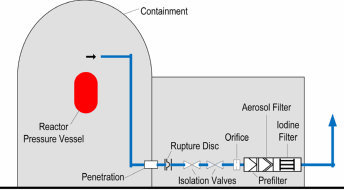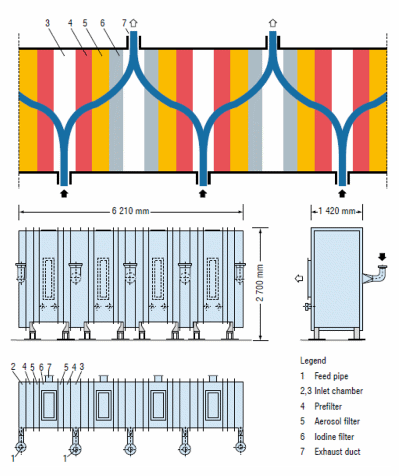Background
Safe and expedient pressure release from reactor containment to the atmosphere must occur so that containment integrity can be maintained if pressure builds up in containment during a severe accident. A filtered containment venting system (FCVS) is necessary to perform such a containment depressurization effectively while minimizing the radioactivity released into the environment. YIT, an internationally recognized filter and HVAC supplier, developed the dry filter method (DFM), an FCVS with very high decontamination factors for radioactive aerosols as well as elemental and organic iodine, for the backfit of German nuclear power stations after the Chernobyl accident in 1986.
Westinghouse, together with YIT, can provide a total solution for the FCVS. Typical scope includes the definition of functional criteria through severe accident analysis to the specification, supply, layout, installation and commissioning of the system, as well as the development or update of plant Severe Accident Management Guidelines. Westinghouse’s dry filter system is the only maintenance-free system that does not require any auxiliary systems for chemistry control, heating and draining. The system is fully passive and does not require any external electric or other power sources during standby or in operational mode. The system’s modular design allows it to be installed in existing buildings or in newly constructed buildings.

Schematic view of DFM
Description
The DFM is a venting system that consists of a combination of two types of filters:
- A metal fiber filter that retains airborne radioactive aerosols (aerosol filter)
- A molecular sieve with doped zeolite for chemisorption of gaseous radioactive elemental iodine and its organic compounds (iodine filter)
A droplet separator prevents water droplets from entering the FCVS. The venting system can be actuated either remotely by opening containment isolation valves or by a rupture disc, depending on regulatory and/or customer requirements.
Aerosol Filter
The aerosol filter removes solid particulates from the venting gas flow. The aerosol filter consists of two filter stages:
- First filter stage (prefilter):
- Metal fiber fleece as the filter medium with fiber diameters decreasing from 65 μm to 12 μm
- Second filter stage (aerosol filter):
- Metal fiber fleece as the filter medium with fiber diameters decreasing from 12 μm to 2 μm Both the filter housing and the filter medium consist exclusively of stainless steel.
Iodine Filter (Molecular Sieve)
The iodine filter is a molecular sieve doped with zeolite for sorption of gaseous elemental and organic iodine. The filter housing consists of bulk beds in parallel for accommodation of the sorption material introduced as a bulk material.
The nearly spherical molecular sieve zeolite was developed specifically for iodine sorption. The iodine to be removed is chemisorbed by silver bound to the zeolite. A catalyst poison in the sorption material prevents catalytic reactions in H2-containing media.
The venting gas expands in a fully passive manner such that the system eliminates the humidity of the steam and optimizes the efficiency of the iodine filter.

DFM filter unit - example of 1,300 MWe PWR
Implementation of the DFM
The DFM venting filter system is a combination of metal fiber and zeolite iodine filter modules. This filter system is designed in modules for easy adaption to meet plantspecific and regulatory requirements. This includes individual sizing of the modules to fit into existing buildings; e.g., the auxiliary building. Requirements for high decay heat loads can be met by implementing passive convection modules in the overall filter configuration.
Qualification
Independent expert consultants, as well as tests conducted at institutes of international reputation, verified the DFM’s conformity with German regulatory requirements.
Both in-house tests and reference tests performed in Germany, France and the United States by application for various techniques of containment venting have confirmed the high standard of the DFM’s filter components.
Benefits
The benefits of the DFM include the following:
- Application of exclusively passive components (no emergency AC or DC power, no coolant water, no chemical supply necessary)
- Very high removal efficiencies demonstrated in various validation tests; typical DFM system efficiencies are:
- Aerosols: > 99.99 percent (DF > 10,000)
- Elemental iodine: > 99 to 99.9 percent (100 < DF < 1,000)
- Organic iodine: > 90 to 97.5 percent (10 < DF < 40)
- Iodine removal efficiencies can be increased by design changes to the iodine filter
- Elemental and organic iodine permanently retained by chemisorption
- Low maintenance cost
- Extremely high-temperature and radiation resistance of the filter components
- Small pressure drop
- All droplets retained in the aerosol filter
- Low risk of condensation-induced H2 accumulation during initial venting due to the low heat capacity of the assembly
- Flexible adaptation to the installation site by modular and individual design (installed filter units backfitted into existing rooms/buildings)
- Seismically rugged due to robust metallic construction of the filter
- Short lead time on delivery
Experience
The DFM has been implemented in seven nuclear power plants in Germany and in one plant in Slovenia in 2013. The product is also under contract in several other countries around the world.













